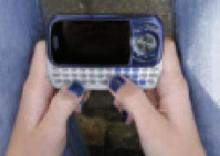• Consider mobile phone texting as a possible cause of tendinitis in the hand. B
• Advise mobile phone users to text with both hands, take frequent breaks, and not type too fast. C
• Advise users to give proper support to their forearms and back while texting. C
Strength of recommendation (SOR)
A Good-quality patient-oriented evidence
B Inconsistent or limited-quality patient-oriented evidence
C Consensus, usual practice, opinion, disease-oriented evidence, case series
In the United States, 173 billion text messages were sent monthly by 293 million cell phone subscribers, according to mid-year 2010 data.1 That’s about 20 daily text messages per subscriber. According to the Pew Research Center, 82% of US adults are cell phone users and 72% of adult cell phone users send or receive text messages.2 Based on a Kaiser Family Foundation study, cell phone ownership is 85% among 15- to 18-year olds, 69% among 11- to 14-year olds, and 31% among 8- to 10-year olds.3 This study reports that 7th to 12th graders, on average, spend 1 hour and 35 minutes each day texting and send 118 messages. Further, only 14% of these young people say their parents have established any rules about the number of texts they are allowed to send. Additionally, based on this same study, girls, older teens, and non-Hispanic blacks spend more time texting than other groups.
Case presentation
A 14-year-old non-Hispanic white girl, right-hand dominant, visited our rural family practice clinic because of “throbbing right thumb pain” that had gradually worsened over the past week. There was no history of trauma, participation in sports, or thumb/hand problems. She had no fever or other symptoms. She was a healthy high school freshman doing well academically. However, she admitted to texting about 4 hours per day for the last 2 years, which her mother confirmed. She was on her family’s unlimited SMS (short message service) texting plan.
During the examination, the patient sat slouched, holding her mobile phone with her right hand while texting with her right thumb. Tenderness of the right thumb was noted on the lateral aspect of the first proximal phalanx, the first interphalangeal joint, and the first metacarpal, especially along the surface of the extensor pollicis brevis, extensor pollicis longus, and abductor pollicis longus (APL) tendons. We noted local soft tissue swelling and mild erythema, but no nodularity was present. Thumb abduction aggravated the pain, which worsened when encountering resistance. There was no tenderness to palpation in the anatomical snuff box. Finkelstein’s test, Phalen’s test, Tinel’s sign, and Hoffman’s sign were negative.
Radiograph results were normal, with no evidence of acute injury, calcifications, or degenerative disease. Hematologic and biochemical investigations, including complete blood count with differential, erythrocyte sedimentation rate, basic metabolic profile, calcium, phosphate, and magnesium, yielded normal results.
These findings suggested a presumptive diagnosis of texting tendinitis. We managed the patient conservatively with a right thumb spica splint, aspirin as needed (pediatric dosing) for analgesia, and education about the proper application of ice. We also instructed her to modify her mobile phone texting activity.
At 1-month follow-up, the patient reported full resolution of her symptoms. In fact, her pain resolved after only 2 weeks of treatment, at which time she discontinued the splint and aspirin. Her parents had limited her mobile phone texting to 45 minutes per day and disallowed it after 8 pm. Soon thereafter, she switched to instant messaging as a means to stay in touch with her social networks (eg, Facebook, MySpace) while using all of her fingers more comfortably on a larger keyboard.
To our knowledge, this case report is the first one published from the United States describing texting tendinitis in an adolescent.
Injuries from texting: More common than we realize?
In The Medical Journal of Australia, Menz described acute texting tendinitis in a 13-year-old girl involving the abductor or extensor pollicis longus muscle; it resolved with conservative management.4 Ming et al subsequently reported a case of progressive first carpometacarpal joint arthritis due to excessive mobile phone texting in a 48-year-old man who recovered after undergoing an excision arthroplasty of the hand.5 Yoong observed texting tenosynovitis among school children who were sending more than 100 text messages daily.6
Storr et al reported on a 20-year-old woman with de Quervain’s tenosynovitis due to texting with her right thumb, and who later developed symptoms in her left hand after learning how to text with her left thumb.7 Similarly, Ashurst et al described a 48-year-old woman who developed bilateral de Quervain’s tenosynovitis from excessive texting activity.8


